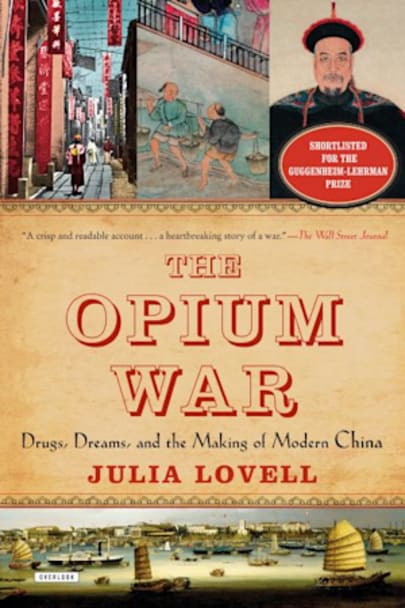In October 1839, a Windsor cabinet meeting votes to begin the first Opium War against China. Bureaucratic fumbling, military missteps, and a healthy dose of political opportunism and collaboration followed. Rich in tragicomedy, The Opium War explores the disastrous British foreign-relations move that became a founding myth of modern Chinese nationalism, and depicts China’s heroic struggle against … against Western conspiracy. Julia Lovell examines the causes and consequences of the Opium War, interweaving tales of the opium pushers and dissidents. More importantly, she analyses how the Opium Wars shaped China’s self-image and created an enduring model for its interactions with the West, plagued by delusion and prejudice.
more



So many of today’s debates about U.S.-China relations focus on the acrimony that Americans and Europeans ascribe to the conflicting political systems and to the economic competition that marks relations between China and the West. In her book The Opium Wars British academic Julia Lovell describes both the historical and the contemporary Chinese distrust of the West which is rooted in a conflict that took place in the first half of the 19th century.
Like Stephen Platt’s recent history Imperial Twilight Lovell describes how in 1839 Great Britain, frustrated by its inability for decades to negotiate a favorable trading agreement with the Qing Empire, took the occasion of 20,000 destroyed chests of Bengal opium to wage war on a dynasty that was already tottering due to internal corruption, civil wars, and natural disasters. The war lasted until 1842, only because communications between the British Far Eastern fleet and London took two months each way (in the days before the Suez Canal and the telegraph). The British made short work of the Chinese, due in large part to the presence of the world’s first armored steamship, HMS Nemesis. Over the course of two years, the British fleet shelled numerous coastal forts along the eastern Chinese seaboard, after which British troops took possession of several key cities, including Canton, Ningbo, and Shanghai. The Nanking Treaty of 1842 gave Britain possession of Hong Kong and trade access to several Chinese ports. Most importantly (and dastardly in Chinese eyes), Britain was allowed to continue trading opium and British subjects were given extraterritoriality, which they managed to retain throughout China until the Second World War.
The role played by the opium trade was key. Without opium brought in from the British East India Company’s colonial territory in Bengal, Britain would have been unable to sustain the trade deficit it had amassed over decades whilst trading silver specie for Chinese tea to satisfy British consumers. Enterprising (or devious, depending on your point of view) traders, such as William Jardine and James Matheson, introduced opium and before long it was the British who were trading at a surplus while the Qing Dynasty was not only running a massive trade deficit, but its population was becoming addicted to this narcotic.
Lovell does a fine job describing the outbreak of war and Britain’s brutal prosecution of it. She also goes on to describe the origins of the Second Opium War (1856-60), which France was only so glad to join in with their new British ally from the Crimean War. The second conflict gave European powers (and the United States) expanded trade rights. At the conclusion, British and French troops took the liberty of sacking the Imperial Summer Palace northwest of Peking and looting priceless treasures (many of which still are on display in Western museums). Where Lovell’s work falls short is the description of the main characters involved in this history. I feel that Platt did a better job of filling in the reader, and his descriptions of the negotiations and the primary and secondary participants are colorful.
The final third of Lovell’s book covers the book’s subtitle: Drugs, Dream, and the Making of Modern China. She explains how this particular conflict, often overshadowed by other Western injustices inflicted by the West and Japan in the latter part of the 19th century—such as the Boxer Rebellion, became the primary victim narrative for China in later years. After China threw off the Qing Dynasty yolk in 1911 (the Qing were Manchus—also foreigners in many Chinese eyes), the young country needed themes to bring together an anarchic, still backward nation. Lovell writes, “Through the 1920s…the historiography of the Opium War acquired a fresh sense of resentment.” Sun Yat-sen, Chiang Kai-shek and other Chinese revolutionary leaders justifiably pointed to the West to ascribe many of China’s contemporary ills. But they also were careful to blame the Qing Dynasty and other feckless Chinese leaders (remember, they had to rely on Western financial support in many cases). After Mao and the Communists took power in 1949, the Opium War gained an even larger status as the original and primary evil inflicted upon the Chinese at the beginning of their ‘century of humiliation.’ Lovell explains, “The Opium War was no longer the turning point in modern Chinese history; it was its inaugural event: ‘the first lesson’ of the Chinese revolution.”
In the face of international opprobrium after the Tiananmen Square Massacre in 1989, PRC leaders were quick to vilify the West, beginning with the attempt to subdue China through opium addiction in the 19th century. Although the point is not altogether wrong, the Chinese leadership would hear nothing of the horrific policies inflicted by the Chinese Communist Party on their own people, such as the ‘Great Leap Forward’ during the late 1950s, and the ‘Cultural Revolution’ of the 1970s. As for the reawakened enmity toward the West (and Britain in particular) in the 1990s, the Opium War was the perfect narrative. “The point of remembering past bitterness was to remind the populace to savour the sweetness of the Communist present.”